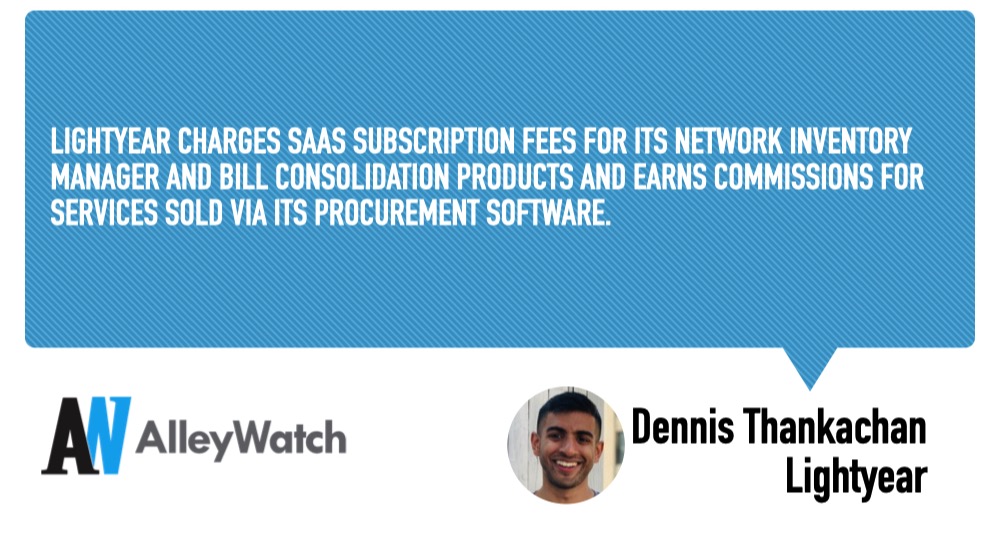Businesses have long struggled with inefficient, time-consuming processes for managing telecom services and expenses. Telecom management has traditionally been beleaguered with manual workflows, fragmented information, and significant administrative overhead for companies. Lightyear is a comprehensive software platform that automates the entire telecom lifecycle for businesses. By providing a digital workflow and system of record, Lightyear enables enterprises to dramatically reduce the time and resources spent on telecom management while simultaneously cutting telecom costs. The company’s innovative approach not only streamlines procurement, network inventory, and bill consolidation but also represents a fundamental reimagining of how enterprises interact with and manage their telecommunications infrastructure. Lightyear is currently working with 300+ enterprises including Alo Yoga, Palo Alto Networks, Five Guys, and Pandora Jewelry.
AlleyWatch caught up with Lightyear CEO and Cofounder Dennis Thankachan to learn more about the inspiration for the business, the company’s strategic plans, latest round of funding, which brings the company’s total funding raised to $48.6M, and much, much more…
Who were your investors and how much did you raise?
Lightyear, the leading provider of enterprise telecom management software, today announces the completion of its $31M Series B fundraising led by Altos Ventures, with meaningful participation from existing investors Ridge Ventures, Amplo, Zigg Capital, and Susa Ventures.
Tell us about the product or service that Lightyear offers.
Lightyear provides enterprises with software that acts as a digital workflow and system of record platform to automate the full enterprise telecom lifecycle, revolutionizing the enterprise telecom experience. Enterprises that leverage Lightyear across the full telecom lifecycle spend exponentially less time on telecom management while reducing telecom costs significantly.
What inspired the start of Lightyear?
 I built a thesis around telecom while working as a public equity investor at a large hedge fund. Upon leaving the firm and investigating a few startup ideas in the space, I began to appreciate how large and impactful business telecom is, while also noting how arcane business telecom procurement processes are. I had the idea to disrupt this space with software, which spawned Lightyear.
I built a thesis around telecom while working as a public equity investor at a large hedge fund. Upon leaving the firm and investigating a few startup ideas in the space, I began to appreciate how large and impactful business telecom is, while also noting how arcane business telecom procurement processes are. I had the idea to disrupt this space with software, which spawned Lightyear.
How is Lightyear different?
Lightyear is the only software product that automates the business telecom lifecycle. Prior to Lightyear, enterprises would have to use spreadsheets, phone calls, and emails with in-house labor to manage telecom, or leverage external consultants to do so.
What market does Lightyear target and how big is it?
The global business telecom market commands about ~$1tn of annual spend
What’s your business model?
Lightyear charges SaaS subscription fees for its Network Inventory Manager and Bill Consolidation products and earns commissions for services sold via its Procurement software.

How are you preparing for a potential economic slowdown?
Telecom is a noncyclical sector that doesn’t see major spending drawdowns in an economic slowdown, which benefits Lightyear. Regardless, Lightyear operates a financially lean operation and maintains a healthy cash cushion to ensure it’s safe from external threats.
What was the funding process like?
We were fortunate to have external VC interest in Lightyear which made the process easier. We weren’t actively running a process to raise capital at the time of our Series B.
What are the biggest challenges that you faced while raising capital?
Early on (our pre-seed and seed rounds) we faced difficulties convincing VCs that telecom software was an attractive venture market to attack. Today, with proof points to validate this thesis, raising capital has been easier.
What factors about your business led your investors to write the check?
Lightyear’s business is noncyclical, recurring, and high-margin alongside a talented team and true barriers to entry.

What are the milestones you plan to achieve in the next six months?
We hope to add significantly to our core three product lines (Procurement, Network Inventory, Bill Consolidation) and to improve our support and operations experience for customers.
What advice can you offer companies in New York that do not have a fresh injection of capital in the bank?
Try to build a business that can succeed with or without the need for external capital. Raising capital is easiest when you’re not reliant on doing so.
Where do you see the company going in the near term?
We hope to become the market leader in telecom procurement software.
What’s your favorite fall destination in and around the city?
Central Park in the fall, right as the leaves are changing, makes me grateful to live in NYC every year!





